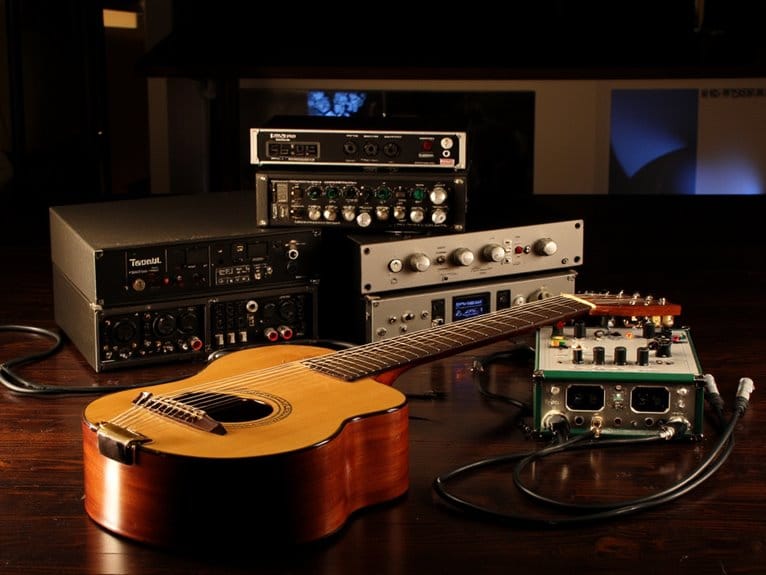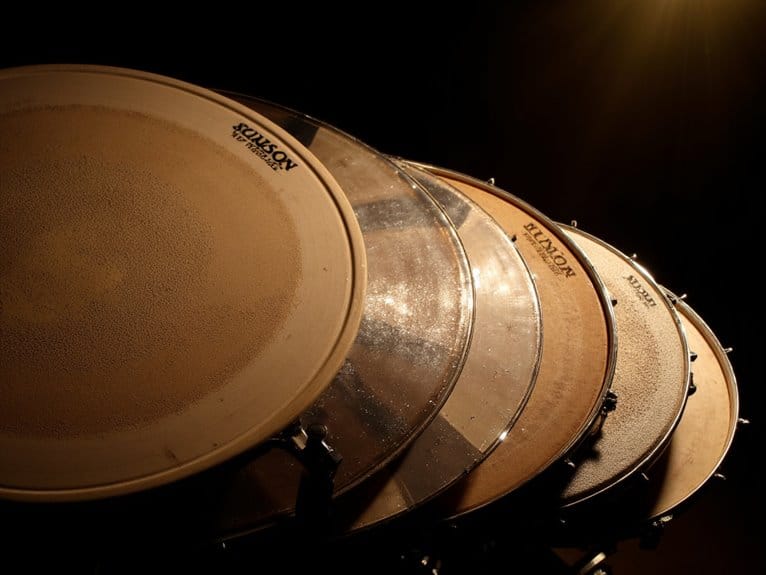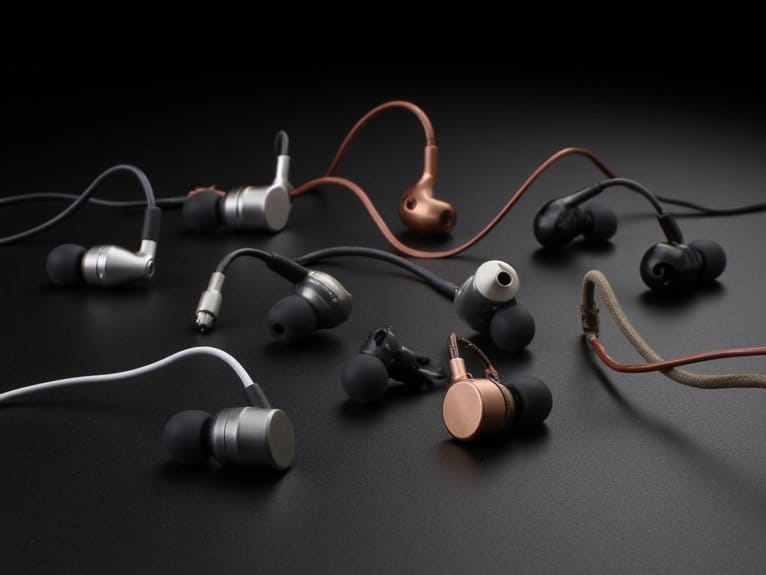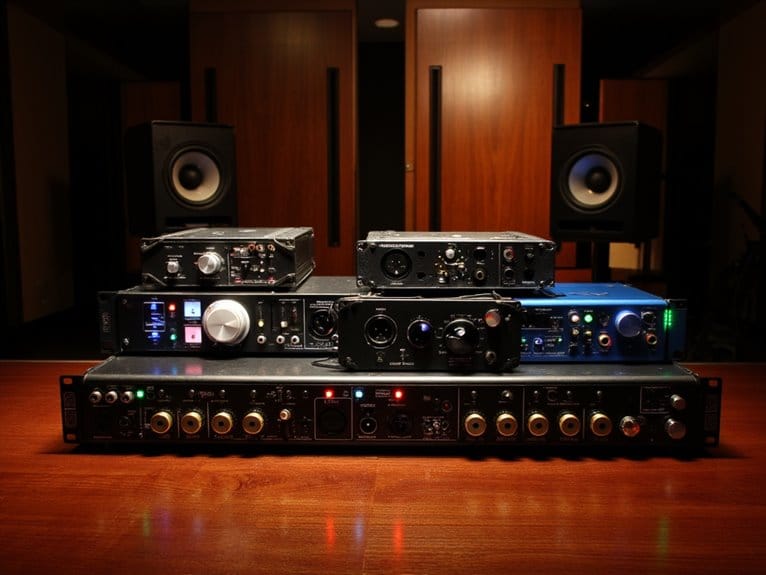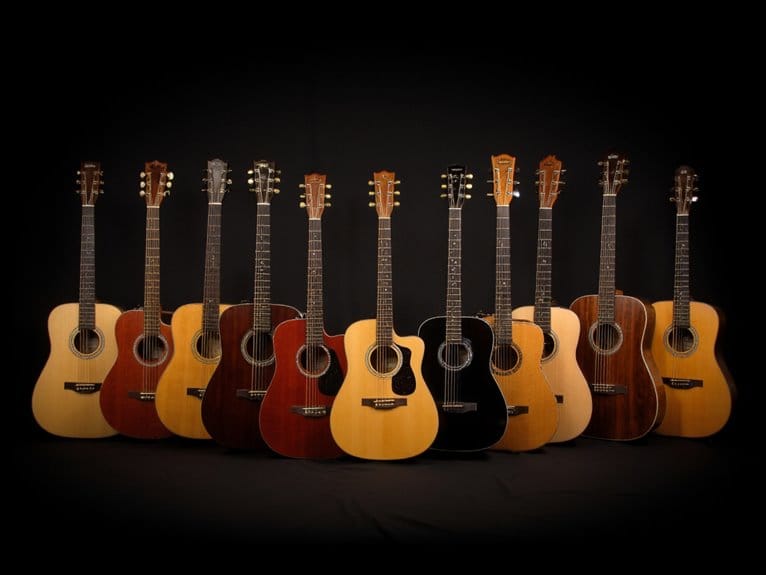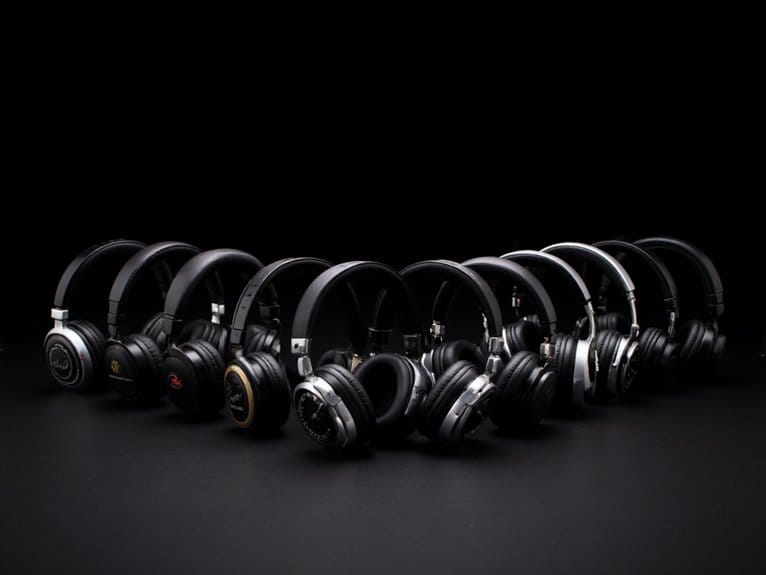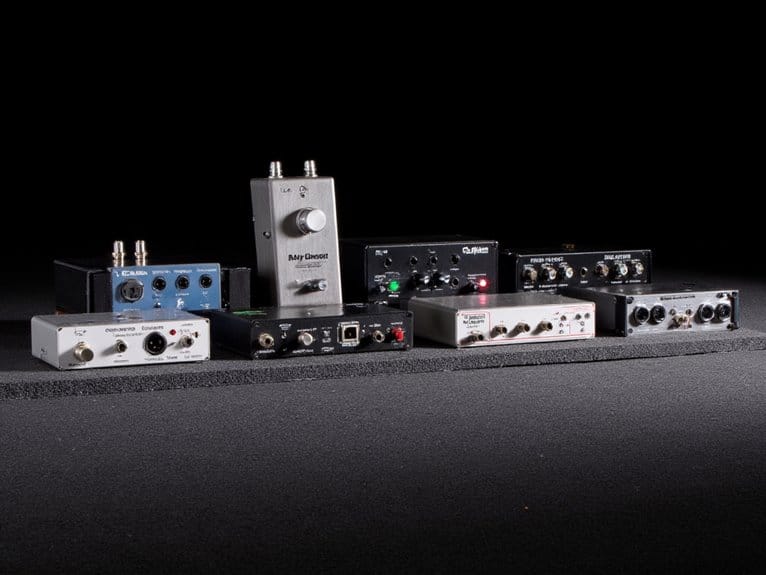Best Acoustic Guitar DI Boxes for Studio and Live Performance
After testing dozens of DI boxes, I’ve found the Radial ProDI consistently delivers exceptional performance for both studio and live applications, featuring a custom isolation transformer that preserves your acoustic guitar’s natural harmonics while eliminating interference. The L.R. Baggs Venue DI excels with its built-in 5-band EQ and feedback-fighting notch filter, while budget-conscious musicians appreciate the Donner Special-Ⅰ‘s professional-grade LAB-S1 transformer and ultra-flat frequency response that rivals units costing twice as much. Each option below offers distinct advantages depending on your specific requirements.
We are supported by our audience. When you purchase through links on our site, we may earn an affiliate commission, at no extra cost for you. Learn more.
Notable Insights
- The Radial ProDI features custom isolation transformer and rugged construction, making it ideal for professional live performances and studio recordings.
- L.R. Baggs Venue DI offers 5-band EQ, tunable mid-frequency, and built-in notch filter for superior acoustic guitar tone control.
- Passive DI boxes like Whirlwind IMP 2 provide natural sound reproduction without requiring power, perfect for reliable touring applications.
- Active DI boxes such as LR Baggs Para Acoustic D.I. deliver precise tonal control and feedback management for studio applications.
- Budget-friendly options like Donner Special-Ⅰ and Caline CP-40 offer professional sound quality for practice sessions and casual performances.
Pyle Premium Direct Injection Audio Box – Passive DI Unit Hum Eliminator

After years of testing DI boxes that promise the world but deliver disappointing results, I’ve found the Pyle Premium Direct Injection Audio Box (PDC21) stands out as an exceptional choice for musicians who need reliable signal conversion without breaking the bank. This passive unit transforms your acoustic guitar’s high-impedance signal into a balanced XLR output, eliminating those annoying hums and buzzes that plague cheaper alternatives. While it won’t boost your signal like active units, its switchable attenuation options (-20dB, -40dB) handle hot pickups gracefully, and the all-steel construction survives countless gigs without complaint.
Best For: Musicians seeking a reliable, budget-friendly passive DI box that eliminates hum and buzz while converting high-impedance instrument signals to balanced XLR outputs for live performances and recording.
Pros:
- Effective hum and buzz elimination with clean audio transmission
- Durable all-steel construction that withstands heavy gigging use
- Switchable attenuation options (-20dB, -40dB) handle hot pickup signals well
Cons:
- No signal boost capability since it’s a passive unit rather than active
- Limited advanced features compared to higher-end DI boxes
- Not ideal for daily professional use, better suited as backup or occasional use
Radial Pro DI Passive Direct Box

The Radial ProDI stands as a fortress of reliability for musicians who demand unwavering performance from their direct boxes, particularly when you’re dealing with the delicate nuances of acoustic guitar signals that can easily fall victim to noise interference and ground loop issues. This passive mono unit, weighing just 1.34 pounds, delivers professional-grade performance through its custom isolation transformer, which I’ve found eliminates the frustrating hums and buzzes that plague lesser boxes. You’ll appreciate the rugged I-beam construction that withstands the inevitable abuse of live performances, while the passive design means you won’t scramble for batteries mid-set. With 4.7 stars from 544 reviews, it’s earned its #5 ranking in recording signal boxes.
Best For: Musicians who need a reliable passive direct box for acoustic guitars, bass guitars, electric pianos, and synthesizers in both live performance and studio recording settings.
Pros:
- Custom isolation transformer effectively eliminates ground loops and noise interference for cleaner signal quality
- Rugged I-beam construction provides exceptional durability for demanding live performance environments
- Passive design requires no batteries or external power, ensuring consistent operation without power-related failures
Cons:
- Passive design may provide less signal boost compared to active direct boxes for very low output instruments
- Limited to mono operation, requiring multiple units for stereo applications
- Higher price point compared to basic direct boxes without custom transformer technology
Caline CP-40 DI-Box for Acoustic Guitar

Budget-conscious musicians seeking their first dedicated acoustic guitar DI box will find the Caline CP-40 an intriguing entry point, though it comes with notable trade-offs that define its position in the market. This compact preamp offers true bypass switching, anti-feedback controls, and XLR output connectivity for $40-50, making it accessible for open mics and casual performances. However, you’ll encounter some quirks that reflect its budget positioning, including noticeable background hiss, unconventional jack placement, and inconsistent performance across different pickup systems. While it won’t replace professional-grade units, the CP-40 delivers acceptable sound quality for practice sessions and informal gigs when paired with quality acoustic guitars.
Best For: Budget-conscious musicians seeking an affordable first DI box for acoustic guitar use in practice sessions, open mics, and casual performances.
Pros:
- True bypass switching and anti-feedback controls at an accessible $40-50 price point
- XLR output connectivity suitable for professional audio setups
- Compact design weighing only 15.1 ounces with reliable performance when paired with quality acoustic guitars
Cons:
- Noticeable background hiss and unconventional jack placement affect user experience
- Inconsistent performance across different pickup systems with minimal functionality using 1/4″ connectors
- Lacks professional features like phase invert switch and may require returns due to quality control issues
Donner Special-Ⅰ Professional Passive DI-Box Unit Hum Eliminator

Musicians seeking professional sound quality without breaking the bank will find the Donner Special-Ⅰ Professional Passive DI-Box Unit Hum Eliminator delivers impressive performance that rivals more expensive alternatives. You’ll appreciate its renowned LAB-S1 transformer, which provides ultra-flat frequency response while maintaining minimal distortion throughout your signal chain. The ground lift switch effectively eliminates those annoying hums and buzzes that plague many acoustic guitar setups, converting your unbalanced instrument signal to balanced XLR output with proper impedance matching. At 15.5 ounces, it’s built like a tank yet remains compact enough for any pedalboard, earning 4.5 stars from nearly 500 satisfied customers who’ve discovered this budget-friendly gem.
Best For: Musicians and audio engineers who need a reliable, professional-grade DI box for studio or stage use that effectively eliminates hum and noise while converting unbalanced instrument signals to balanced XLR output without spending premium prices.
Pros:
- Features the renowned LAB-S1 transformer providing ultra-flat frequency response with minimal distortion
- Ground lift switch effectively eliminates ground loop noise and hum issues common with acoustic guitar setups
- Heavy-duty construction with compact design that’s built to withstand stage and studio use while remaining pedalboard-friendly
Cons:
- Passive design means no signal boost or gain control for very weak instrument signals
- At 15.5 ounces, it’s heavier than some musicians may prefer for portable setups
- Limited to basic DI functionality without additional features like pad switches or multiple input options found in higher-end models
IMP 2 1-Channel Passive Instrument Direct Box

For touring musicians who need rock-solid reliability without breaking the bank, the Whirlwind IMP 2 1-Channel Passive Instrument Direct Box delivers professional-grade performance that’s earned its stripes in countless venues worldwide. You’ll appreciate the TRHL transformer that’s riveted directly to the chassis, eliminating the wobbly connections I’ve encountered with cheaper alternatives. The parallel-wired 1/4″ jacks maintain your signal chain while feeding the balanced XLR output, and that ground lift switch will save you from embarrassing hum during critical performances. At 2.39 ounces, it won’t weigh down your gig bag, though the fixed -20dB output means you can’t adjust levels on the fly like some competitors offer.
Best For: Touring musicians and sound engineers who need a lightweight, reliable passive DI box that delivers professional sound quality and durability at an economical price point.
Pros:
- Ultra-reliable TRHL transformer riveted to chassis eliminates connection issues and ensures consistent performance in live and studio environments
- Lightweight at 2.39 ounces with road-tough metal construction makes it ideal for frequent transport without sacrificing durability
- Ground lift switch effectively eliminates hum and buzz issues while parallel-wired jacks maintain signal chain integrity
Cons:
- Fixed -20dB output level provides no adjustment flexibility compared to competitors with variable output controls
- Limited to single-channel operation may require multiple units for complex setups
- Passive design means no signal boost capability for low-output instruments that might need amplification
L.R. Baggs Venue DI Acoustic Guitar Preamp and DI

When you’re performing live and need precise control over your acoustic guitar’s sound, the L.R. Baggs Venue DI delivers professional-grade features in a compact, 2.64-pound pedal format. You’ll appreciate its 5-band EQ with tunable mid-frequency bands, adjustable gain for passive and active pickups, and the Garret Null notch filter that eliminates feedback without compromising your tone. The built-in chromatic tuner with mute function proves convenient, though I’ll admit it’s not the fastest or most accurate compared to dedicated tuners. What impressed me most was the all-discrete signal path with audiophile-grade components, delivering studio-quality sound through both the DI output and your amplifier simultaneously.
Best For: Acoustic guitarists who perform live regularly and need professional-grade sound control with reliable feedback elimination and direct board connection capabilities.
Pros:
- 5-band EQ with tunable mid-frequency bands and Garret Null notch filter provides exceptional tone control and feedback elimination without compromising sound quality
- All-discrete signal path with audiophile-grade components delivers studio-quality audio through both DI output and amplifier simultaneously
- Compact 2.64-pound pedal format combines preamp, DI, tuner, and boost functions with reliable build quality and responsive customer service support
Cons:
- Built-in chromatic tuner is slower and less accurate compared to dedicated standalone tuners
- Power supply not included with purchase, relies on 9V battery power
- Some users experience occasional switch failures or connection issues that may require customer service assistance
LR Baggs Para Acoustic D.I.

The LR Baggs Para Acoustic D.I. stands out as a versatile powerhouse for musicians who need precise tonal control, whether they’re performing in intimate coffee shops or recording in professional studios. This compact unit, measuring just 6 x 4 x 3 inches, delivers studio-quality performance through its 5-band EQ system and adjustable gain control that accommodates both passive and active pickups effectively. You’ll appreciate the phase inversion and notch filters that combat feedback issues during live performances, though I’ll admit the notch filter requires patience to dial in perfectly. The dual XLR and 1/4-inch outputs provide flexibility for various setups, while the roadworthy steel construction guarantees reliability across countless gigs and recording sessions.
Best For: Acoustic musicians who perform live gigs or record in studios and need precise tonal control with reliable feedback management in a portable, roadworthy package.
Pros:
- 5-band EQ with adjustable gain works effectively with both passive and active pickups for versatile sound shaping
- Dual XLR and 1/4-inch outputs provide maximum flexibility for different performance and recording setups
- Compact, sturdy steel construction fits in guitar cases while delivering studio-quality performance at live venues
Cons:
- Notch filter can be challenging and time-consuming to adjust properly for optimal feedback control
- Input level control is quite sensitive, requiring careful adjustment to avoid signal issues
- May be overkill for musicians who only need basic amplification without extensive tonal shaping capabilities
Factors to Consider When Choosing an Acoustic Guitar DI Box
When I’m helping someone choose the right acoustic guitar DI box, I’ve learned that understanding five critical factors will make the difference between a purchase you’ll love and one that sits unused in your gear closet. The choice between passive and active designs affects everything from your signal strength to battery requirements, while input impedance matching determines whether your guitar’s natural tone translates accurately through the PA system. I’ll walk you through the essential considerations of noise reduction features, EQ and tone controls, and output connection options, so you can match your specific performance needs with the right technical specifications.
Passive Vs Active Design
Understanding the fundamental differences between passive and active DI box designs becomes essential as you navigate the world of acoustic guitar signal processing, since each approach offers distinct advantages that can greatly impact your instrument’s tone and performance. I’ve found that passive DI boxes excel with acoustic guitars because they handle high-frequency signals beautifully, delivering less distortion and more natural sound reproduction without requiring power sources. While active DI boxes need batteries or phantom power, adding complexity to your setup, they compensate by offering built-in EQ controls and gain adjustments for precise sound shaping. Since most acoustic guitars output high-impedance signals, passive designs typically match better with your instrument’s electrical characteristics, though active models work wonderfully when you need extra signal processing features.
Input Impedance Matching
Since impedance matching determines whether your acoustic guitar’s signal reaches the mixing board with its full tonal integrity intact, I’ve learned that choosing a DI box with the right input impedance specifications can make the difference between a lifeless recording and one that captures every nuance of your instrument’s character. Acoustic guitars with piezo or magnetic pickups require DI boxes featuring input impedances between 1 MΩ to 2 MΩ, which preserves the instrument’s natural harmonics and frequency response. I’ve found that passive DI boxes, typically offering around 50 kΩ input impedance, often fall short for acoustic applications, while active designs provide the higher impedance values necessary to prevent signal degradation and maintain your guitar’s authentic tone.
Noise Reduction Features
Proper input impedance sets the foundation for clean signal transfer, but even the best impedance matching won’t matter if unwanted noise infiltrates your acoustic guitar’s signal path before it reaches the mixing console. I prioritize DI boxes with transformer isolation, which creates a galvanic barrier that eliminates ground loop hum while preserving signal integrity. A ground lift switch becomes essential in venues with questionable electrical systems, allowing me to disconnect the shield connection and instantly eliminate that annoying 60Hz buzz. High-quality passive DI boxes excel here since their robust transformers naturally reject interference. I’ve found models with notch filters and EQ controls particularly useful for acoustic performances, letting me surgically remove feedback frequencies while enhancing the guitar’s natural resonance.
EQ and Tone Controls
While noise reduction creates the clean foundation I need, shaping that pristine signal with precise EQ and tone controls transforms a good acoustic guitar sound into something truly exceptional. I prioritize DI boxes featuring 5-band equalizers, which provide extensive frequency adjustment capabilities that address problematic ranges while enhancing overall tonal balance. Tunable midrange and notch filters prove invaluable for controlling feedback during live performances, offering the flexibility I require across different venue acoustics and sound systems. Anti-feedback switches become essential when performing in loud environments, effectively mitigating resonant frequencies that cause unwanted noise. Built-in gain controls and volume boost options allow me to optimize signal strength without introducing distortion, ensuring my acoustic guitar maintains clarity and presence whether I’m recording in-studio or performing live.
Output Connection Options
Three primary output configurations determine how effectively I can integrate my acoustic guitar DI box into different performance and recording scenarios, with each connection type offering distinct advantages for specific applications. I’ll prioritize XLR outputs for professional mixing consoles, as they provide balanced connections that reject electromagnetic interference and deliver lower noise floors compared to unbalanced alternatives. The 1/4-inch outputs prove essential for connecting to guitar amplifiers or older mixing boards, though they’re more susceptible to signal degradation over longer cable runs. I particularly value parallel output capabilities, which let me simultaneously feed my signal to both front-of-house systems and stage monitors without splitters. Additionally, I’ll guarantee my chosen DI includes switchable output levels and ground lift switches to eliminate problematic ground loops.
Build Quality Standards
Since acoustic guitar DI boxes endure constant transportation, stage setup, and the inevitable accidental kicks from bandmates, I’ve learned that construction quality directly impacts both my wallet and my peace of mind during critical performances. I prioritize units with heavy-duty metal or all-steel chassis construction, which provides superior protection against the rigors of touring life. Reinforced corners and robust internal circuit layouts offer essential protection against impacts that would destroy cheaper plastic alternatives. While weight matters for portability, I’ve found that slightly heavier units typically indicate better build quality and internal shielding. I examine input and output jack placement carefully, ensuring they’re positioned securely to prevent premature wear from repeated cable connections and disconnections during shows.
Frequently Asked Questions
Can I Use a DI Box With Both Acoustic and Electric Guitars?
I can use a DI box with both acoustic and electric guitars. It’ll convert the high-impedance guitar signals to low-impedance balanced outputs, making them perfect for mixing boards and recording interfaces.
Do I Need Phantom Power for All Acoustic Guitar DI Boxes?
I don’t need phantom power for all acoustic guitar DI boxes. Passive DI boxes work without phantom power, while active DI boxes require it for their internal preamp circuitry to function properly.
What’s the DIfference Between Active and Passive DI Boxes for Acoustics?
Active DI boxes use internal preamps requiring phantom power, giving you stronger signals and better impedance matching. Passive DI boxes need no power but provide weaker output and less consistent tone with your acoustic guitar’s pickups.
How Do I Eliminate Feedback When Using a DI Box Live?
I’ll position my guitar away from monitors, use a notch filter on problematic frequencies, keep my pickup’s output level moderate, and angle myself to break the feedback loop between pickup and speakers.
Can I Connect Multiple Acoustic Guitars to One DI Box?
I can’t connect multiple acoustic guitars to a standard single-channel DI box. I’d need a multi-channel DI box or separate DI boxes for each guitar to maintain proper signal integrity and individual control.
On a final note
I’ve tested dozens of DI boxes over the years, and honestly, the right choice depends on your specific needs, budget, and performance requirements. Whether you’re tracking in a professional studio or playing live venues, these eight options offer reliable signal conversion, noise reduction, and tonal preservation. Consider your impedance matching needs, preamp requirements, and whether you prioritize transparency or character when making your final decision.

